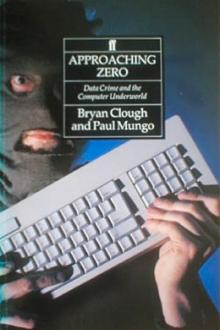Approaching Zero by Paul Mungo (bts book recommendations .txt) 📖

- Author: Paul Mungo
- Performer: -
Book online «Approaching Zero by Paul Mungo (bts book recommendations .txt) 📖». Author Paul Mungo
hackers.
The Soviet secret service’s list of sites included the Pentagon, NORAD, the
research laboratories at Lawrence Livermore and Los Alamos, Genrad in Dallas,
and Fermilab in Illinois, as well as MIT, Union Carbide, and NASA’s Jet
Propulsion Laboratory. It was a shopping list of top-secret defense
contractors and installations. The list continued with names of companies in
the U.K. and Japan. The KGB stipulated that it was interested in micro-electronics projects for military and industrial purposes—specifically in
programs for designing megachips, the electronic brains that were responsible
for the military strength of the Western allies. Two French companies in
particular attracted the KGB’s attention: Philips-France and SGSThomson, both
known to be involved in megachip research.
Koch knew that on the sites picked by the KGB he would be confronted with VAX
computers, which were made by DEC, but he had no experience with VMS, the
proprietary operating system used by VAXen. It was VAX expertise he was hunting
for at the Chaos congress: someone to make up for the skills he lacked.
It was lucky, then, that he met a seventeen-year-old hacker from West Berlin
named Hans Hubner. Hubner, a tall, slender young man with the paleness that
comes from staring at a computer screen too long, had been fascinated by
computers since he was a child. He was also addicted to an arcade game that
involved a little penguinlike character called Pengo. He liked it so much that
he adopted Pengo as his handle.
When he met Koch, Pengo was unemployed and desperately needed money. He also
shared Koch’s liking for drugs, but more important, he had experience with VMS.
Since 1985 he had been playing on Tymnet, an international computer network run
by the American defense contractor McDonnell Douglas, and had learned to use
the VAX default passwords—the standard account names that are included with
the machines when they’re shipped out from the manufacturer. Pengo was also one
of the first German hackers to break into CERN, the European Nuclear Research
Center in Geneva, Switzerland, and was a caller to the Altos bulletin board in
Munich—where, coincidentally, he had met Fry Guy, the Indiana hacker.
Koch befriended the young Berliner, invited him to Hannover, and introduced him
to Peter Kahl. Before long Pengo had become the second member of the gang,
operating from what was then West Berlin, while Koch continued his activities
in Hannover. Kahl later involved a contact in West Berlin, Dirk Brescinsky,
whose job it became to run Pengo.
Koch and Pengo had some early successes hacking into VAX machines. They
discovered that DEC’s Singapore computer center was exceptionally lax about
security. From there they were able to copy a VMS program called Securepack,
which allowed system managers to alter user status.
It was a useful piece of software for the KGB. But it wasn’t military data. To
get into defense sites, Pengo and Koch knew they needed to find a more certain
way into VAXen.
They didn’t have long to wait: within six months security on VAX systems
worldwide would be blown wide open.
Steffen Wernery became entangled in the conspiracy because of his peripheral
involvement in compromising VAX security. In the autumn of 1986 Hans Gliss, the
editor of Datenschutz-Berater who had been so helpful to Chaos over the Btx
affair, contacted Steffen. Gliss needed help and told the young hacker the
following story:
Gliss had been working as a consultant for SCICON, one of the largest computer
software companies in Germany. SCICON had been awarded a lucrative contract by
the government for work that was “very important, high security, requiring
maximum reliability.” It involved three networked VAX computers in three
locations, with the head office in Hamburg.
During the final phase of testing SCICON was contacted by a computer manager in
northern Germany and asked to explain the messages—short bursts of characters
and digits in no discernable order—that had been seen on his computers. From
the computerized routing information it was clear that the messages were
emanating from SCICON in Hamburg, but they made no sense to him or anyone at
his institute, or to anyone at SCICON.
The SCICON researchers checked through their security logs—computer files that
record all the comings and goings of users on the system—and quickly realized
that the dated and timed messages had all been originated “out-of-hours,” at
times when no authorized users would be active. Further investigation showed
that some new user IDs and passwords had been added to their system that no one
could account for. The implications, Gliss said, were all too obvious: hackers
had penetrated SCICON security and were using their computers as a launching
pad to other systems.
What Gliss now needed to know was if Steffen had any idea who might be
involved. If SCICON couldn’t guarantee the security of the system, the entire
contract with the German government would be at risk. Gliss needed to find out
who the hackers were, how they got on, and how to stop them. Contacting Steffen
was a long shot, but he was a leading member of Chaos and knew most of the
hackers in Germany. Perhaps he could make some calls.
Steffen thought about it: He reasoned that because the hackers were breaking
into the SCICON site in Hamburg, they were probably based in the city. It made
sense to call a nearby computer; that way the phone bills were cheaper.
Two days later he called Gliss and said that he had identified the hackers—two
Hamburg students. They had agreed to meet Gliss and help—provided that he
promise not to prosecute, so Gliss gave his word.
Later that week he met the two students, code-named Bach and Handel, in
Hamburg. Their story was worrying: the two students had exploited a
devastatingly simple flaw in the VMS operating system used on VAX. The
machines, like most computer systems, required users to log in their ID and
then type their password to gain access. If the ID or the password was wrong,
the VMS system had been designed to show an “error” message and bar entry. But
the two hackers told Gliss that if they simply ignored all the “error”
messages, they could walk straight into the system—provided they continued
with the log-on as though everything was in order. When confronted with the
“error” message after keying in a fake ID, they would press Enter, which would
take them to the password prompt. They would then type in a phony password,
bringing up a second, equally ineffectual “error” message. By ignoring it and
pressing Enter again, they were permitted access to the system. It was
breathtakingly easy, and left the VAX open to any hacker, no matter how
untalented.
For SCICON staff the situation was disastrous. To deliver their contract on
time, they would need to find the flaw in the operating system and fix it. At
first they turned to DEC for help, but with time running out, SCICON’s
programmers began looking for a solution themselves, tearing apart the VAX
operating system line by line. They were looking for a bug in the program that
would prevent it from operating correctly, or an omission in the commands that
would allow hackers to simply ignore the “error” message.
To the SCICON team’s surprise, they didn’t find one. What they discovered
instead was a piece of program code that appeared to have been deliberately
added to the operating system to provide the secret entrance. To the SCICON
researchers it looked like a deliberate “back door.”
Back doors are often left in computer programs, usually to facilitate testing.
Generally, they allow writers of things like computer games to jump quickly
through the program without having to play the game. For example, in the
mid-1980s a game called - Manic Miner involved maneuvering a miner level by
level from the depths of his mine up to the surface, the game becoming
progressively harder at each level. The programmer whose job it was to test the
game needed a shortcut between levels, so he introduced back doors that would
take him directly to any one of his choosing. Inevitably, some players stumbled
onto the hidden routes, which—ironically—increased the game’s popularity.
Often back doors, or “cheat modes,” are deliberately built into games,
encouraging the player to try to break the rules. Some computer magazines give
tips on how to find the cheat modes; some games, such as the popular Prince of
Persia, are said to be impossible to win without using them. Back doors might
also be introduced for more mercenary reasons: legend has it that programmers
include back doors on arcade games they create, and then supplement their
incomes by playing the games at venues such as nightclubs and casinos, which
offer prizes.
Some arcade back doors are well known. Occasionally, players stumble across
them by making some noninstinctive move: for example, on certain computer
gaming machines the instinct is to “hold” two lemons (if three lemons wins a
prize) and then spin for the third lemon. But this strategy almost never wins.
However, if the player doesn’t hold the two lemons and simply respins, the
three lemons will automatically come up. On another arcade
game, one which offers a sizable jackpot, it is said that the player brave
enough to refuse it and start the machine again will be rewarded by winning two
jackpots.
On a more sophisticated level, back doors are also provided on operating
systems for emergencies. Access to these back doors is reserved for the
computer manufacturer; procedures for gaining entry to the system from the
emergency back doors are highly confidential, highly complex, and not the sort
that could be stumbled over by accident.
The back door on the VAXen, though, was out in the open. It wasn’t simply for
emergencies; its security was far too trivial.
The VAX operating system, VMS, had been subjected to stringent tests and was
supposed to comply with the exacting “orange book” security standards
established by the U.S. Department of Defense. Under the orange-book testing
program, technically qualified intruders attempt to break through the security
features of a computer; the tests can take up to six months, depending on the
level of security required. It strained belief that VMS could have gone through
such testing without the back door being discovered.
Responding to complaints from its users, DEC issued a “mandatory patch,” a
small program designed specifically to close the back door, in May 1987. But
despite the “mandatory” order, many users didn’t bother to install it, and for
a short time, VAX computers across the world provided hackers with an open
house if they knew about the security gap.
Back doors are, of course, deliberate. They aren’t simple bugs in the program
or errors in the system: they are written by a programmer for a specific
purpose. In the case of the VAX back door, the who and why remains mysterious,
though it is clear that whoever created it had to have access to the VMS source
code, its basic operating instructions. One rather farfetched, though not
impossible, idea is that hackers broke into DEC and amended VMS to make it more
hospitable. Or perhaps a programmer put the commands in without the knowledge
of the company so that he could access VAX machines throughout the world
without IDs or passwords. Another more intriguing theory is that the back door
was built by the National Security Agency for its own use, though this
presupposes that the NSA is in the business of spying on computer users.
Yet some people do suppose precisely that. In their view it is a myth that the
NSA is interested in protecting computer security. Instead, it may be actively
engaged in penetrating computers or more bluntly, hacking—all over the world
by exploiting back doors that only the agency knows about.





Comments (0)